
The Pirate Surgeon's Quarters: 1 2 3 4 5 6 7 8 9 10 11 12 Next>>
The Pirate Surgeon's Quarters in the Golden Age of Piracy, Page 7
Location of the Surgeon: The Orlop Deck
In battle, the surgeon set up his operation theater on the Orlop Deck. He kept his stores here - plasters, bandages, tools and medicines. This was also where the medicines were prepared by the surgeon's assistants and mates. Indeed, his apprentices and surgeon's mates would have their quarters here as he himself might have if there weren't a cabin available to him. On a pirate ship, where the organizational structure was generally flatter, the surgeon would almost certainly have resided on the orlop near his equipment and supplies.
During the golden age of piracy, the orlop was one of the names given to the deck located just above the hold (bottom) of the ship.1
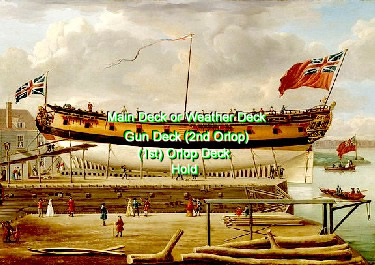
Artist: John Clevely the elder
The (Presumed) Deck Plan of a 24 Gun 6th Rate Sloop-of-War (1758)
While this definition sounds nice and neat to our modern sensibilities which demand conciseness, terminology in the golden age of piracy was quite malleable. In 1623, Henry Mainwaring defined the orlop deck in his Dictionary.
The Orlopp is noe other but the Deck; as we say, the Lower Deck, the second Deck, so you may as well say the Lower Orlopp, or the second Orlopp: and indeed it is comonly held the proper speech to call them the first Orlopp, and the second Orlopp; for this word Orlopp seemes to be appropriated only to theis two Decks: for if a Ship have three Decks, they never call the Upper most (which is ye third) by the name of Orlopp, but by the name of Deck: as (to speake of them,) they will say She hath a Tire of Ordinans [tier of Ordnance] on the first and second Orlopps, and also upon the Upper Deck, and not upon the Upper Orlopp.2
While Mainwaring is content to confine the orlop to the bottom two decks
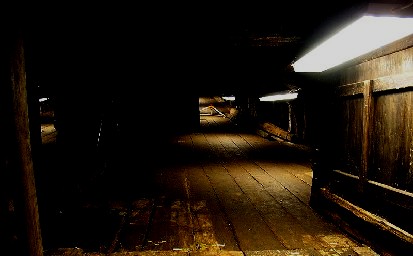
Photographer: Peter Isotalo
The Orlop Deck of the Swedish Warship Vasa, a 17th century vessel
above the hold, John Smith adds to that somewhat as noted in his 1691 sea dictionary: "[Y]our risings are above the first Orlop as the Clamps are under it, which is long thick Planks like them, fore and aft on both sides, under the ends of the Beams and Timbers of the second Deck or Orlop, or the third Deck or Orlop, and yet that are all but Decks."3 You almost get the idea that every deck below the main deck could be referred to as an Orlop deck during the golden age!
For our purposes, we are going to use the definition of the orlop as being the one above the hold, because this is the most commonly held definition and it is where the sea-surgeon was headquartered. This is in part because the orlop deck was near or below the waterline. It was the safest place during attack making the surgeon less likely to be wounded while the ship was in a fight. (As a bonus, the already wounded would also be less likely to become further wounded.)
The orlop deck usually had no gun ports, since it was normally below the water line. During battle, the cockpit on the orlop "became an operating and dressing station [while] the adjoining platform, or orlop [deck], served as a collecting center [for casualties] and ward."4 Modern sea-surgeon and historian John J. Keevil noted that the cockpit was a good site "because it was comparatively immune from direct hits, and not only could the surgeon work uninterrupted, but he was more secure than if he had been on the gun decks above."5
To help understand the location of an orlop deck, you can look at the period schematics of the naval warship HMS Blenheim, a 2nd Rate Ship below. In 1710, the Blenheim carried 26 guns on each of the three gun decks, 12 on the Quarter Deck and 4 on the Forecastle for a total of 94.6
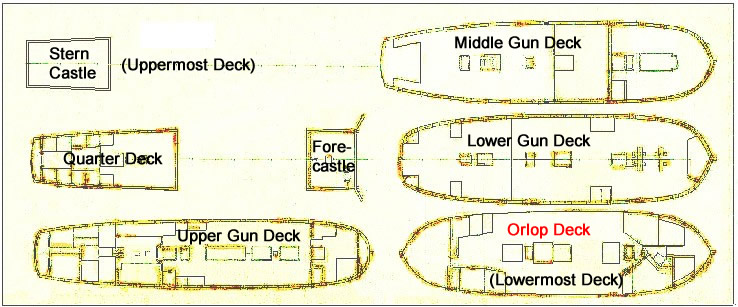 The Decks of the Blenheim - based on schematics from the National Maritime Museum (1709) |
Now, fascinating though this is, it is in not very representative of the average pirate surgeon's situation. Ships were often measured by their burthen or burden, which is the estimated carrying capacity or 'tonnage' of the ship7. The Blenheim had a burden of 1557 tons8 - four times the largest pirate ship as we saw in the Large Pirate Ships Table in previous pages! Pirates had more than just tonnage or gunnage in mind when they procured a ship as we have already learned.
So let's look at the plans for the pirate brig Mercury, a modern draught of a period-era ship created by William Pace. Although it is not an actual period vessel, William based it upon several different sloops, particularly the 1711 drawings of the HMS sloop-of-war Ferret. Like the Ferret, the Mercury has been converted into a Brig-sloop with the addition of a foremast.9 The drawings (or 'draughts') below show the cutaway side profile and a top view of the orlop platform.
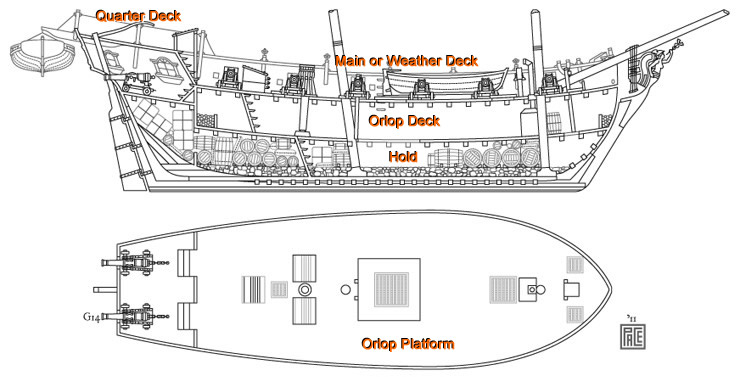 The Mercury Sloop-Brig, Designed and Drawn by William Pace based on the HMS Ferret - Used with Permission |
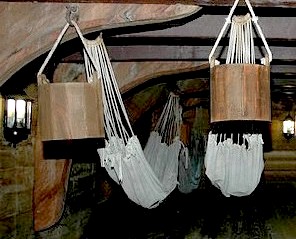
The Orlop Deck of a Brig
Notice how many fewer decks there are on this brig-sloop than the naval vessel. There are also no cabins on the orlop deck of the Mercury while the Blenheim contains multiple separate compartments and cabins all along the outside of the ship.
Naturally, a sloop would be a much smaller craft and would have a much shorter orlop deck. The Mercury's orlop deck is approximately 52 feet long and 16 feet wide at its' widest point. The Blenheim's orlop deck is roughly 150 feet long by 33 foot at its widest. You see that there is quite a difference between the two ships! Note also that the Mercury's orlop deck has been shortened in the rear by the raised deck used to mount two stern chaser cannons; apt for a pirate's craft but not helpful to the surgeon trying to establish space for his surgery during battle.
In addition, the Mercury really only has one usable lower deck, so that would be where the men went when they were not topside. This would create a crowded environment for the surgeon and his mates to work in during non-battle conditions. Of course, the ship's surgeon had little choice in the matter and could only adapt himself to whatever conditions he found when captured by pirates.
1 Orlop Deck, wiktionary.org, gathered 11/9/12; 2 Henry Mainwaring, The Seaman's Dictionary cited at Orlop, www.bruzelius.info, gathered 11/9/12; 2 John Smith, The Sea-mans Grammar, p. 6; 4 R. S. Allison, "Chirurgeon: Look to the Wounded," J Royal Medical Serv 1990, p. 16; 5 John J. Keevil, Medicine and the Navy 1200-1900: Volume II – 1640-1714, p. 55; 6 British second rate ship of the line 'Blenheim' (1709), threedecks.org, gathered 11/4/12;7 Builder's Old Measurement, wikipedia, gathered 11/5/12; 8 British second rate ship of the line 'Blenheim'; 9 Pirate-era Sloop cross-section?, pyracy pub forum, posted 4/12/09 by William Red Wake (Pace), gathered 11/13/12

